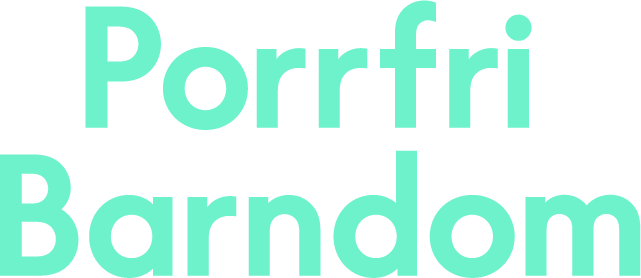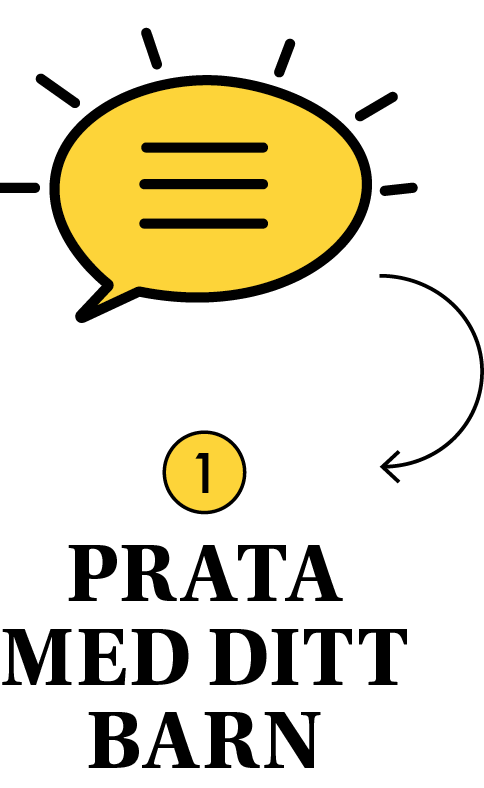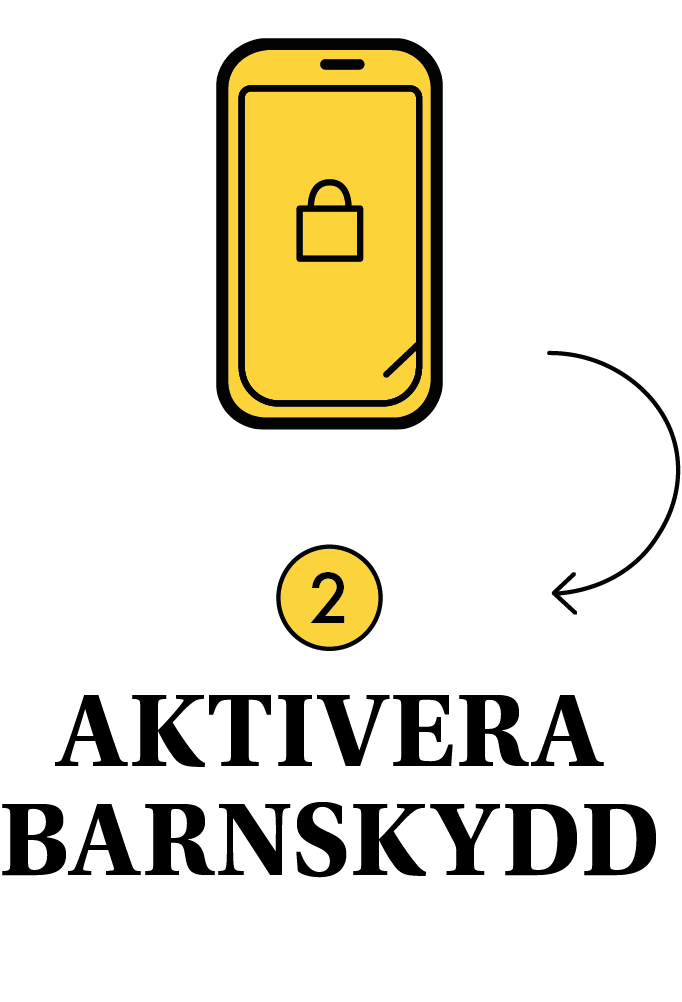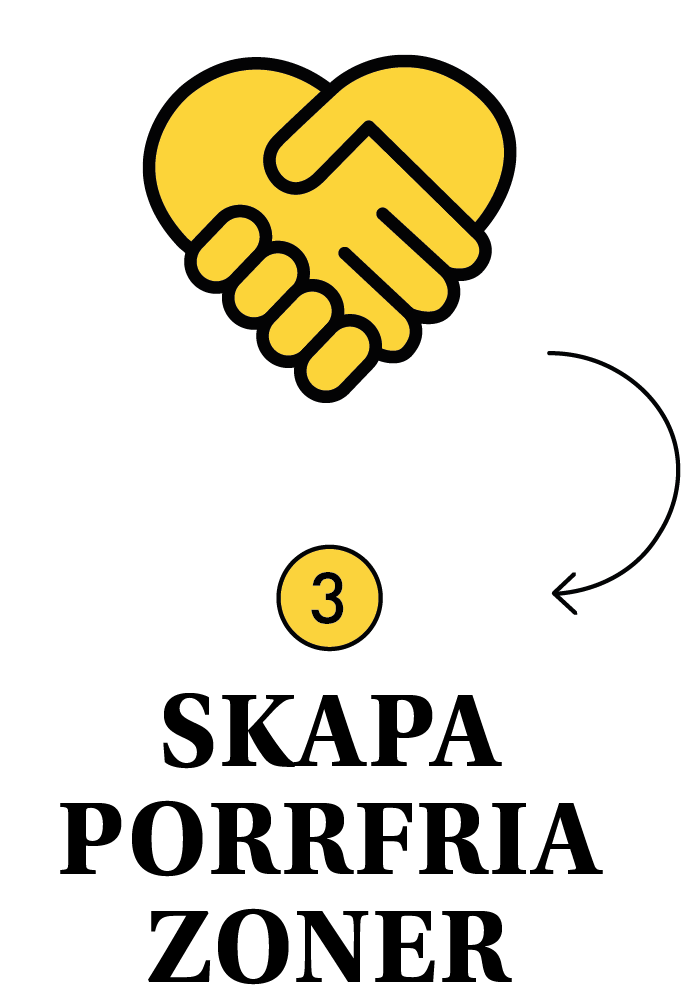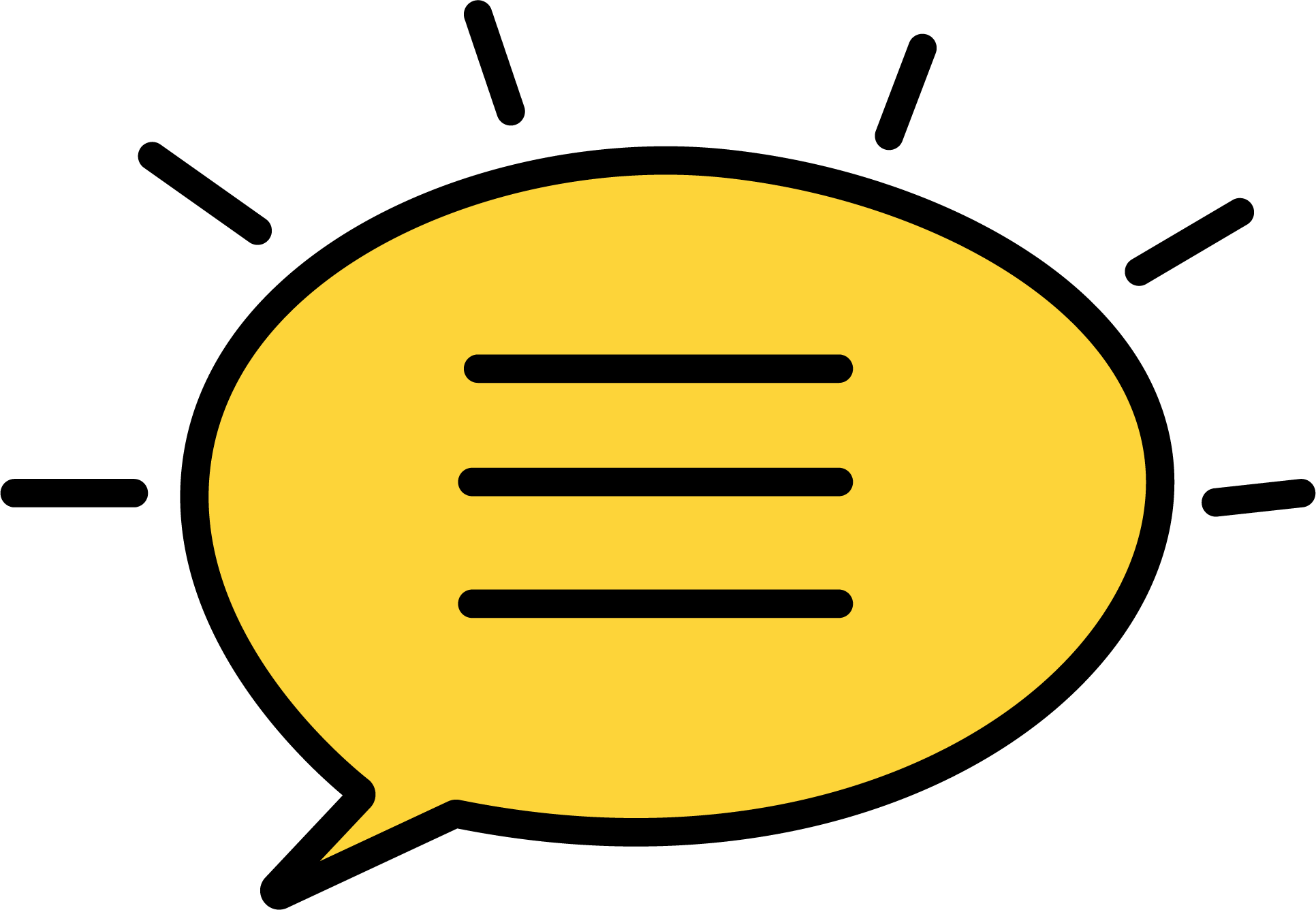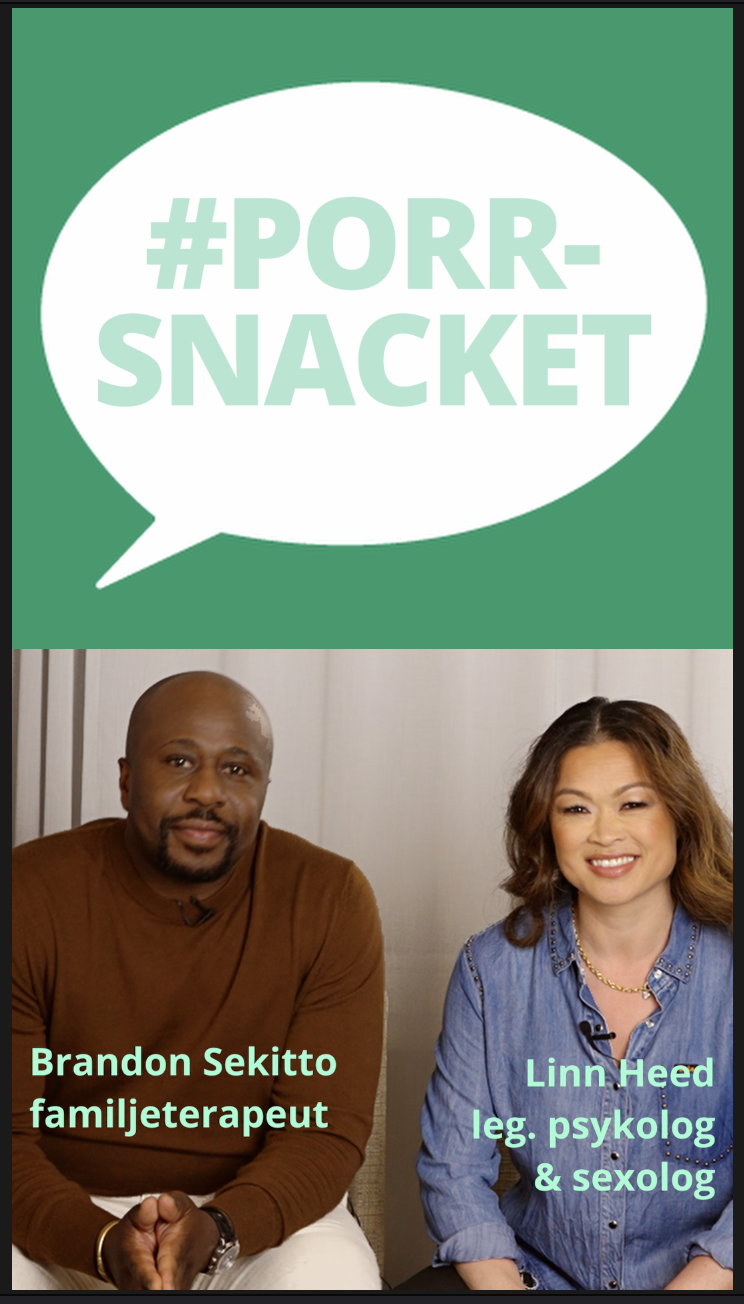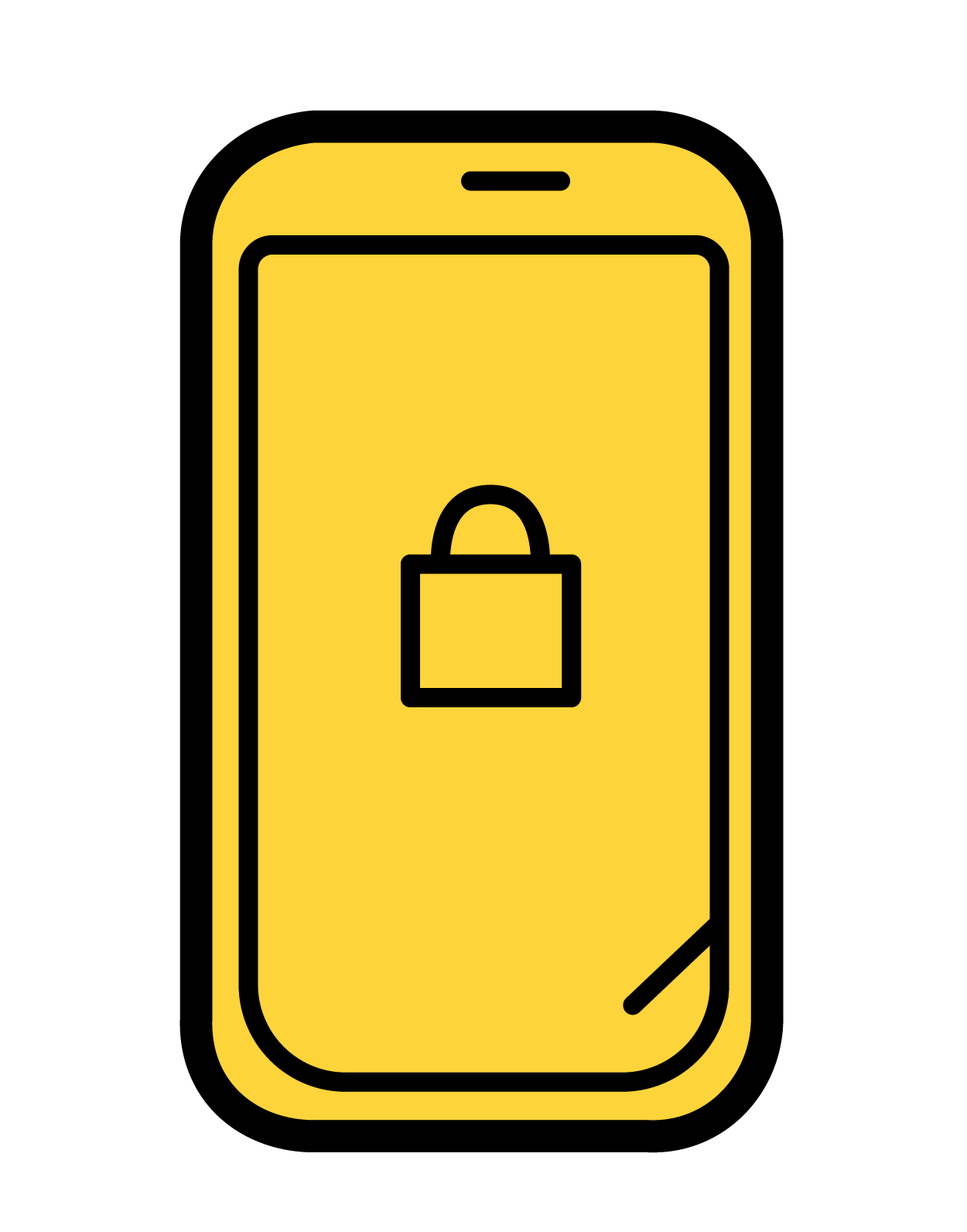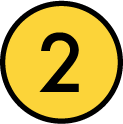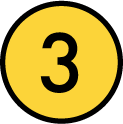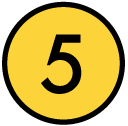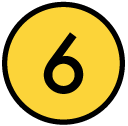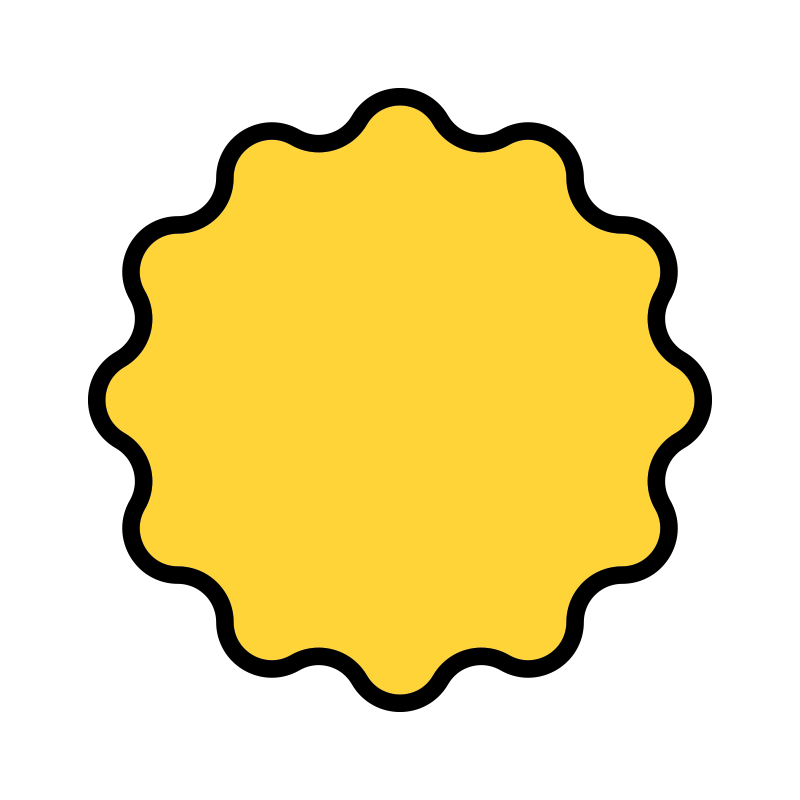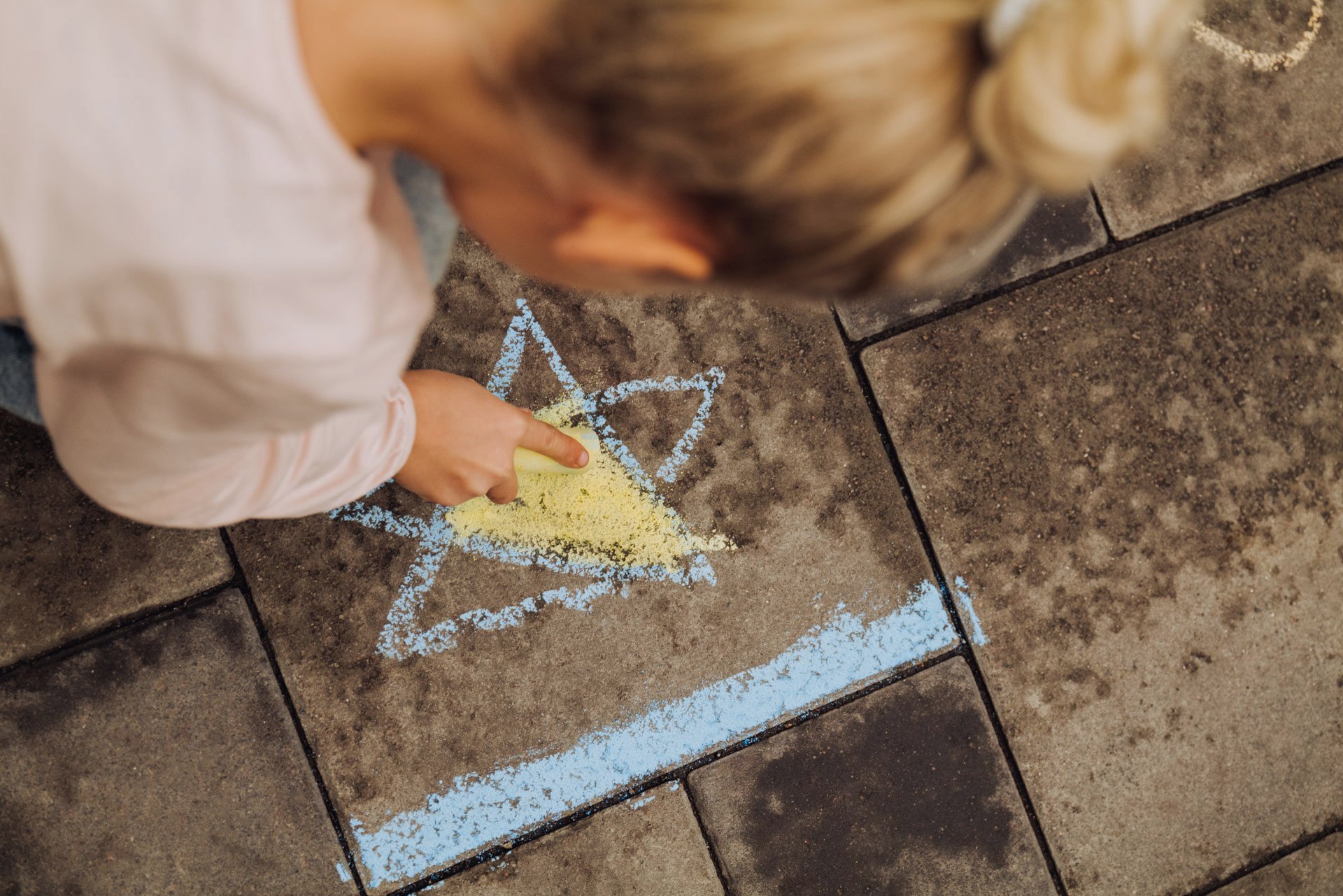
TALK SUPPORT PROTECT:
PRESCHOOL CLASS AND PRIMARY SCHOOL CHILDREN
INCREASE SAFETY AROUND YOUR CHILD
Here you’ll get help to talk to your child and increase online safety in 3 simple steps:
STEP 1:
TALK TO YOUR CHILD
Here we have compiled some expert tips on how to talk about pornography to a child in preschool class & primary school. Yes, unfortunately we do need to talk about it at such a young age because it’s common for children that young to be exposed and you can reduce the damage if you get in first. However, instead of introducing the word “porn”, you can say pictures & videos with nudity.
It’s important to adapt the conversation to your particular child, since children of the same age can be at different levels. You’re welcome to take a look at the tips for junior school, so you know what we highlight there.
HAVE THE TALK IN TIME!
– My child is too little.
– My child has no interest in that kind of thing.
– It’s probably not that serious.
– My child tells me everything.
– It’s too uncomfortable to think about.
– I’m afraid of getting it wrong.
– I’ll do it later.
No matter what: Always have the talk!
That’s how we can help children in an individual & age- appropriate way.
SIMPLE EXPERT TIPS FOR PARENTS OF CHILDREN IN PRESCHOOL CLASS & PRIMARY SCHOOL:
-
Many children in preschool class and primary school don’t know the word “porn” or know what it is. Avoid the word if your child hasn’t already heard it, so they don’t Google the word and be exposed to pornography. Instead, tell them that there are things on the internet that are not suitable for children to see. Like pictures and videos containing nudity, in which some people don’t respect other people’s private body parts and sometimes even hurt each other.
-
If your child hasn’t already learned, tell them which body parts are private: willy, vagina, bottom, mouth, inside of the thighs and breasts for older girls. Also tell them that your private body parts are your own and that everyone can only touch their own private body parts. It’s also important to say that the whole body must be respected and that no-one may touch you in a way that makes you feel uncomfortable.
According to the Swedish National Agency for Education curriculum, children must be taught about bodily privacy at preschool. Many preschools use the material entitled “Respect! My Body!” from Save the Children. The material is available to download if you want to use it with your child.
-
When, as adults, we ask for consent, we show that the child’s and other people’s bodily privacy is important and is something that goes without saying. Physical contact with another person must always feel good for everyone involved, before, during and after. One example is to offer a hug using words and body language and wait until the child gives a “yes or no signal”. That’s how we teach a child that their own and other people’s bodies must be respected.
-
Teach your child that it’s up to the person who takes the physical initiative to get consent. For example, you can say to your child, “If you want to hug or tickle someone, first ask them if they want to do it as well.” For example, the child could ask: “Do you want a hug?”, “Is that OK with you?" or "Do you want to be tickled?".
If you teach your child to ask at an early age, it might be easier for the child to accept a no. The child might not feel so rejected if they’ve asked a question in order to check the situation. Tell them that it’s perfectly OK to feel sad, angry or disappointed when you get a no. The no must nevertheless be respected. Tell them that words like “not now,” “wait,” and “stop” can also mean no. Some preschools are working on Make Equal’s book “Okej med dig?” [OK with you?], which is about consent. If you want to use it, it’s available to download.
-
It’s also important to tell your child that it’s perfectly OK for them to say no, even if it disappoints the other person. It can be a good idea for you and the child to come up with a couple of responses together for when the child don’t want physical contact with someone. One example might be “No thanks, I’ve run out of hugs today” or “Here’s a ‘high five’ instead”.
-
The vast majority of children don’t tell an adult if they’re exposed to pornography. To make a child more likely to tell you, you can ask the child to think about which adults they feel safest with in various ordinary situations. Question: “Who would you most like to talk to at school if something happens that makes you feel uncomfortable?” Mention other places such as after-school club, leisure activities, at their best friend’s house, etc.
It’s a good idea to repeat the exercise once every three months so it’s fresh in the child’s memory and the child can think of a new person if an after-school club leader leaves, for example. If the child has thought about it in advance, they’re more likely to go to an adult if something that makes them feel uncomfortable happens. Just the same as it’s easier to get out of a building when there’s a fire if you’ve memorised where the fire exits are.
The child is even more likely to tell if they’ve told their safe adults that they’ve been chosen and has received a warm reaction. Then, in a way, they’ve already started the conversation and it can be much easier to actually dare to tell the adult if something that makes them feel uncomfortable happens. So encourage your child to tell their chosen adults.
-
Finding out that a child has been exposed to pornography can give rise to powerful emotions in an adult. If that happens, it’s important for you to put your own feelings on hold and focus entirely on the child’s feelings. Listen to how the child is feeling, ask open-ended questions to get an idea of what the child has seen and how the child has reacted. Speak calmly and show that you won’t get angry. Also show that you can listen no matter what the child tells you and that you’ll always help and support the child. Be sure to unburden the child of any feelings of guilt and shame.
Bear in mind that children don’t want to make adults sad or angry and that overwhelming reactions can mean that the child won’t want to tell you next time they’re exposed to pornography. The aim is for the child to dare to talk about it next time as well and to want to have an ongoing dialogue with you while they’re growing up. Thank the child for the trust they have shown in you by daring to tell you and say that you’re happy that the child is talking to you about what happened.
Always focus on the child and acknowledge the child’s feelings in every conversation, whether the child has been exposed to pornography unwillingly, has searched for pornography themselves, has seen others watching pornography or is just curious.
-
There is often racism in pornography in a way that would be unthinkable in most other contexts. For example, many porn sites allow you to choose which people you want to watch based on race. Porn videos are often divided into categories such as "Japanese", "Arab" and "Indian" etc.
The porn industry also often sexualizes tragedies in society. For example, BLM (Black Lives Matter) porn, refugee porn and corona porn were created in connection with each tragedy.
Porn racism, like other porn genres, is often completely uncommented on by the adult world and children are left alone with the impressions. What children can see, however, is the normalizing like button on e.g. "Bound naked young Oriental slave on her knees taught how to suck cock" listed on Pornhub, January 1, 2023, 72% likes. Read more about porn racism here. -
It is particularly important to emphasize the inviolable and equal value of all human beings for the youngest children, who find it particularly difficult to relate to the impressions of pornography. Talk to your child in a positive way about differences. You have a very important task to build a strong foundation that gives your child resilience to the influence of pornography.
Positive inclusion exercise
By asking simple inclusive questions, you can help your child to self-reflect on positive aspects of different origins.
What's the best thing about looking different?
What different languages can the children in your class speak?
What words do you know in other languages?
-
We need to be concrete with children about the content of pornography to build as much resilience as possible - without saying too much - preferably before they have been exposed. Tell them that there are things on the internet that children should not see, such as videos and pictures of nudity where people are treated badly because they have a different color skin. Explain that unfortunately some people hurt others and are mean to each other and that this is very bad. Emphasize that it is wrong to say something mean or hurt someone because they are a certain gender or look a certain way. Tell them that if they see something like that, they should always go to an adult they feel safe with and tell them.
-
Incest-themed, "barely legal," and "teen" are some of the biggest trends on some of the most popular mainstream sites with millions of movies that are free and accessible to anyone regardless of age. Therefore, it is common for children as early as preschool class and primary school age to be exposed to this type of, e.g. by an older child at school showing.
Examples of videos from two of the world's most popular sites are:
"SisLovesMe – Shy Stepsister With Puffy Nips Mazy Myers Gets Her Tiny Pussy Stretched By Stepbro" – 34.4K views, 87% likes. Listed January 11, 2023 on Youporn.
"STEPFATHER FUCKS TINY TEEN BECAUSE HIS WIFE WOULD NOT" – 10.9M views, 87% likes. Listed January 11, 2023 on Pornhub.
-
This type of movies are often high up on the front pages as soon as the children enter the sites and it is common for children already at primary school age to be exposed to so-called "incest", e.g. by an older child at school showing. It can be very harmful for children to see where it looks like adults or siblings are abusing children. Read more in our knowledge section How are children affected? This is a complex and serious problem. If you think a child has been exposed and is not feeling well, we recommend that you seek professional help, e.g. from the school counsellor. For more information, see How are children affected?.
In general, other expert advice applies here as well: Talk calmly, lift off any guilt or shame, listen to the child's feelings, try not to transfer your own feelings.
Repeat with the child that penis, vagina, buttocks, mouth, throat, inner thighs and breasts for older girls are private body parts. Read more about private body parts, bodily integrity and "Stop! My body!" at Save the Children, Save the Children, Save the Children and Treskablinoll.
Try to find out if the child has been exposed to by asking open-ended questions and without saying the word, if the child does not already know that word. Instead of the word, you can ask if the child has seen pictures and videos with nudity.
-
Explain that unfortunately there are pictures and videos on the internet where adults touch children's private body parts, that it is wrong and that it should not be so. Explain that it is not good for children to see pictures or videos of adults or other children touching children's or adults' private body parts.
Explain to the child that no adult, or any child, is allowed to touch, photograph or film their private body parts or ask the child to touch the child's own or someone else's private body parts.
List a few examples so that it becomes concrete and the child understands which ones it is about. For example, you can say to the child: "Not teachers, recreation leaders, football coaches, a friend's siblings or parents, cousins or anyone else in the family.
-
Emphasize that it is never the child's fault or responsibility if this happens. Tell them that it's common for children to feel bad and sad, and that it's okay to feel sad and feel bad. Tell the child that it is important that the child tells an adult with whom they feel safe if it has happened.
Seek professional help if necessary. We always encourage you to report to the police if a child has been subjected to a crime.
-
Sometimes children feel guilt or shame when they’ve been watching pornography and it’s important for adults to unburden the child of those feelings. One way of doing that is to tell them that it’s never a child’s “fault” if they’ve seen pornography and by showing that we won’t get angry. Another way is to tell the child that it’s adults’ job to protect children from things that aren’t suitable for them to see on the internet and that you’ll do your best to make sure it doesn’t happen again.
-
Children need their parents’ insight, help and involvement just as much in their online world as they do offline. Show just as much interest in what your child is doing in both worlds. Sit next to your child while they’re browsing and ask what they’re doing. Ask whether your child wants to show you things they think are fun and teach you about apps and games. Showing interest is an important way of building trust and gaining insight. Then it becomes natural to talk about different things online, including things that may feel more uncomfortable.
-
We recommend complying with age recommendations on the various social media platforms. It’s normally easier if you come to an agreement about that with other parents at your child’s school, after-school club or group of friends before the children get phones and start creating social media accounts.
-
It’s common for children to send one another links to material that’s not child-friendly, such as links to porn sites. Tell your child that links from other people can lead to things that’ll scare you or make you feel bad and that your child should always ask an adult if they feel unsure before clicking on a link. Tell them that you’ll never be angry if something happens that makes the child feel bad. Unburden the child of any feelings of guilt or shame they may have, keep calm and listen to the child.
-
When your child starts to come into contact with social media on their own phone or an older sibling’s or friend’s phone, there is a risk that the child may be contacted by adults who want to harm the child through so-called grooming. Be on the alert about your child’s contact with social media. There are adults who send messages and nude pictures to a child or ask the child to send nude pictures of themselves or to take pictures of their siblings or friends and send nude pictures of them. So it’s important to teach children about private body parts and tell them that no-one is allowed to ask the child to photograph and send pictures of their private body parts. Also, tell them not to share private information such as their name, home address, school, etc.
Help your child register a username on social media instead of using their own name since that reduces the risk of someone who wants to harm them being able to search for them. Also help to activate privacy settings on the child’s accounts.
Tell them that you’ll never get angry if something happens and that you’ll always help and support them. Unburden the child of any feelings of guilt or shame and thank your child for having the confidence in you to tell you. Get professional help if you need it, e.g. from a school counsellor.
You can read more about nude pictures and grooming and get more advice on the Swedish Police website. If you suspect that a sexual offence is being committed against a child online, you must report it to the police.
-
Tell your child that no-one is allowed to send the child nude pictures of private body parts or ask the child to send nude pictures. Say that if this does happen, it’s important for the child to go to an adult that they feel safe with and tell them. Explain that you lose control of pictures and videos once you’ve sent them and they can easily be spread on the internet and remain there forever.
Nude pictures and videos of minors can end up on porn sites and it can be very difficult to get them taken down and they can also be uploaded again. Minors can get help to try and take down nude pictures that have been spread online at dittecpat.se.
Tell them that you’ll never get angry if something happens and that you’ll always help and support them. Make it clear that it’s never the child’s fault if someone spreads their pictures. Unburden the child of any feelings of guilt or shame and thank the child for having the confidence in you to tell you. Get professional help if you need it.
-
Have the talk in an everyday situation that’s comfortable for you both. For example, conversation usually flows well when you’re moving or doing something together, such as going for a walk or cooking. Examples of questions to initiate the conversation:
Show interest in the child’s internet. Ask what the child likes and ask the child to show you what they do and what they watch.
Ask questions in the third person. Has anyone in their class watched or shown videos containing nudity?
Ask whether the child is curious about sex and what they know about sex and what they’d like to know. You can say that you understand if the child is curious about what the body looks like or what it looks like when someone has sex.
One convenient way to start the conversation is to use a third party as a starting point. For example, put an age-appropriate book or article on the kitchen table, such as Save the Children’s folder “Respect! My Body!” on consent for younger children.
-
You’re welcome to read on, but don’t think that you need to be skilled to have the perfect big talk. If you do think that, it often doesn’t come off or it happens after the child’s first exposure to pornography rather than before. None of us is skilled in this area, which is also developing at lightning speed. For example, the pornography industry is constantly finding new ways of marketing itself and there are new trends as far as content is concerned. The important thing is that no child should to be left alone with experiences from pornography that can be traumatising. So don't put off the talk!
-
If it feels awkward to talk to your child, bear in mind that you’ve talked about things that felt uncomfortable before, perhaps if the child experienced something nasty on TV or someone was getting bullied at school. You know your child. Trust your relationship and have confidence that you’ll find your way in this conversation as well. Children often want to talk to adults about both positive and negative powerful experiences, but they don’t always bring them up themselves. It’s therefore important for us adults to have the talk regularly!
It’s important to adapt the conversation to your particular child, since children of the same age can be at different levels. You’re also welcome to take a look at the tips for junior school , so you know what we highlight there.
The expert tips have been developed in consultation with our experts in the Inheritance Fund [Swedish Inheritance Fund] project The New Normal, including:
Linn Heed
Licensed psychologist, licensed psychotherapist, sexologist
Brandon Sekitto
Family therapist, intercultural communicator
Lotta Kajving
School counsellor, behavioural scientist and certified sex counsellor
Dani Lind
Producer of the film “High Speed Internet Porn and the Experiment Generation"
Mikis Kanakaris
Activity developer & discussion leader, stiftelsen 1000 Möjligheter & Unga Relationer
Read more about how children are affected by porn here!
Adults entice children to
send nude photos of themselves on
How can you talk to your child about commercial sexual exploitation?
We caught up with Gabriella Kärnekull Wolfe, Ombudsman against Commercial Sexual Exploitation of Children (OKSE), to get her best advice for parents.
STEP 2:
ACTIVATE DIGITAL CHILD PROTECTION
Did you know that Apple & Google, as well as other companies, have their own free digital child protection that you can activate for your child? There’s no such thing as watertight protection, but they limit the risk of younger children being accidentally exposed to sites containing violence and pornography, etc.
Följ stegen nedan för att skydda ditt barn från att exponeras för porr & våld. Det är enkelt, gratis och tar bara 60 sekunder! Aktivera både Apples och Googles barnskydd om ditt barn använder Apples produkter, alltså en iPhone, iPad eller Mac-dator.
Apples produkter
1. Gå in på “Inställningar”
2. Klicka på “Skärmtid”
3. Klicka på (iOS) “Begränsa innehåll/integritet”, (Macbook) “Innehåll och integritet”
4. Välj (iOS) “Begränsa innehåll/integritet”, (Macbook) “Innehåll och integritet”
5. Klicka på (iOS) “Affär, webb, Siri och Game Center”, (Macbook) “App Store, medier, webb och spel”
6. Klicka på (iOS) “Webbinnehåll", (Macbook) “Tillgång till webinnehåll" och välj "Begränsa vuxet innehåll”
7. Backa till “Skärmtid”, klicka på “Använd lösenkod för Skärmtid” & välj en 4-siffrig kod
Google SafeSearch
1. Gå in på google.se
2. Klicka på “Inställningar”
3. Klicka på “Sökinställningar”, under SafeSearch och välj “Dölj explicita resultat”
4. Klicka på “Spara” längst ner på sidan
Du kan optimera barnskyddet på Googles webbläsare genom att skapa ett eget konto till barnet där du uppger barnets ålder, då förstår Google att det är ett barn som använder webbläsaren.
KLART!
Här nedan finns en ännu tydligare beskrivning med skärmvyer.
Apple products
Activate
Go to “Settings” and tap “Screen Time”
Tap “Content & Privacy Restrictions”
Enable “Content & Privacy Restrictions”
Select “Content Restrictions”
Tap 'Web content'
Tap "Limit Adult Websites"
To further enhance safety on an Apple iPhone, you can tap “Use Screen Time Passcode” under “Screen Time” and choose a 4-digit passcode. The code is then requested for access to the sites restricted by Apple.
DONE!
Also activate Google SafeSearch if your child has an iPhone
Google SafeSearch
Visit google.se
Tap “Settings”
Tap “Search settings”, under SafeSearch and select “Filter"
Tap “Save” at the bottom of the page
DONE!
Also activate it on iPads and computers.
Also activate Google SafeSearch if your child has an iPhone or an Android phone.
PRINT AND DISTRIBUTE:
"ACTIVATE APPLE & GOOGLE CHILD PROTECTION IN 60 SECONDS"
Create a pornography-free zone around your child by giving out our guide on how to activate Apple & Google child protection in 60 seconds to all parents with children at your child’s school, after-school club, basketball team & in their group of friends! The only way to protect your child is to protect all the children around your child.
A QR code in the guide also leads to age-appropriate expert tips on how to have that all-important porn talk!
Spread it also digitally e.g. in Whatsapp chats & email loops with other parents!
Effective & super easy!
STEP 3:
CREATE PORNOGRAPHY-FREE ZONES AROUND YOUR CHILD
It is common for children to expose each other to pornography – often as young as primary school age! You can create pornography-free zones around your child by distributing our child protection guide with Google SafeSearch & Apple Child Protection to other parents in your child’s class at school, your child’s group of friends & basketball team.
-
Digital child protection is used to limit involuntary exposure to online pornography for younger children of preschool, primary and junior school age. No digital child protection is one hundred per cent reliable and it must always be combined with regular individual and age-appropriate conversations.
As a parent, you can’t sit back and assume that child protection will do all the work and that your child can tell the difference between sex and the aggressive acts that happen without consent in pornography. Fortunately, you can make a big difference by talking to your child.
-
Digital child protection has the same effect as Systembolaget. It’s not impossible to buy alcohol or get around digital child protection, but they limit access to some extent. Raising the age for first exposure makes a big difference. It’s often more difficult for younger children to cope with their reactions.
There is no watertight protection, but digital child protection reduces the risk of younger children being accidentally exposed to sites with violence and pornography, which is often very crude today with violence and humiliation. Of course, protection should always be combined with conversation.
-
There are millions of free porn sites on the internet that can be accessed without restrictions by anyone, regardless of their age. It’s common for children to be exposed to pornography against their will as young as primary school age, for example by being shown it by a friend or an older sibling. It’s common for mainstream pornography to contain degradation and physical aggression such as strangulation and “gagging”. It also often alludes to incest. Because of the ease of access, pornography has become a primary source of sex education, sometimes the only source, for many children. Children also expose other children to acts they’ve seen in pornography. Read more here about how children can be affected by pornography.
-
Myth: "Digital child protection always removes LGBTI information and sex education pages."
Facts: It is easy to check that a digital child protection service does not delete pages with sex education and LGBTQI information, e.g. umo.se. umo.se, rfsu.se, rfsl.se and snaf.se. It is just as easy to correct if a particular webpage is removed by mistake.
Myth: 'Digital child protection does not work'
Facts: Digital child protection refers to younger children of pre-school, primary and secondary school age where it has a significant effect. There is no digital child protection that is 100% effective, just as there is no door lock, smoke detector or vending machine that is 100% effective. Door locks can be broken, smoke alarms can be broken and it is possible to ask a person over 18 to buy alcohol. Anyone who wants to get around a digital child protection system will always be able to do so, but society limits various things that are harmful to children as much as possible. Digital child protection also has an important normative signaling value. There are different types of digital child protection that are more or less effective. It is therefore important to test the chosen option regularly and to combine digital child protection that limits younger children's exposure to pornography with porn-free policies, individualized and age-appropriate regular porn-critical education and conversations.
Myth: "Digital child protection is counterproductive because it contributes to a lack of conversation."
Fact: Research at Uppsala University* in 2016 shows that only a few of the children in the study had talked to an adult about pornography. At that time, the majority of municipalities had not activated digital child protection against pornography in schools, and similarly, very few parents had activated child protection for their children on private digital devices, yet the conversations did not take place. In other words, the calls are usually not made regardless of whether or not there is digital child protection - unless adults actively initiate the calls. Therefore, it is important that porn prevention includes a comprehensive solution that limits younger children's contact with pornography, combines digital child protection with porn-free policies, individual and age-appropriate regular porn-critical education and porn-critical conversations.Source:
*Magdalena Mattebo, Uppsala University, 2016
-
In 2022, the Council of Europe passed a resolution strongly recommending that all 46 Council of Europe Member States reduce approximately 100 million children’s exposure to pornography. The Council of Europe thus urges the Swedish government – which has still not acted to protect Sweden’s children from pornography in accordance with the Resolution – to meet and guarantee the Council of Europe’s requirements.
Porrfri Barndom has contacted the government to follow up on whether the government will act in accordance with the Council of Europe’s Resolution. So far, the government has not answered the question. Porrfri Barndom continues to follow up in order to get answers.
The Council of Europe has published the following text on the Council of Europe website:
“Digital devices should have built-in adult content blockers to protect children
All digital devices should have easy-to-use parental controls and tools for filtering and blocking pornographic material built into them by default in order to combat children's exposure to adult content, the Assembly said. These control tools should be “systematically activated in public spaces, such as schools, libraries and youth clubs”.
Unanimously adopting a resolution based on the report prepared by Dimitri Houbron (France, ALDE), the parliamentarians expressed deep concern at “the unprecedented exposure of children to pornographic imagery, which is detrimental to their psychological and physical development”. This exposure, they said, “brings increased risks of harmful gender stereotyping, addiction to pornography and early, unhealthy sex.””
Read the the Council of Europe publication in full here!
-
Ask your municipality if there is digital child protection in the municipality’s facilities for children such as schools, after-school clubs and libraries. You can send our pre-written citizen proposal “Hej kommun!" [Hello Municipality!] to your municipality’s info-mail or to the Chairperson of the Municipal Executive Board, regardless of whether or not the municipality accepts citizen proposals. Also ask whether there is digital child protection in your municipality on open wi-fi networks in public environments where children are present such as restaurants, shopping malls, play facilities, libraries, etc.
We can work together to drive development and increase child safety!
PRINT AND DISTRIBUTE THE LEAFLET:
"HOW TO INCREASE ONLINE SAFETY AROUND YOUR CHILD!"
Create a pornography-free zone around your child by giving out our info sheet on how to activate Apple & Google child protection in 60 seconds to all parents with children at your child’s school, after-school club, basketball team & in their group of friends! The only way to protect your child is to protect all the children around your child.
A QR code in the guide also points to age-appropriate expert tips on how to have the important pornography talk!
Also spread it digitally, e.g. in Whatsapp chat & email loops with other parents!
Effective & super easy!
Give out the info sheet at your next parents’ meeting!
-
One hot tip is to talk to one or more parents before the parents’ meeting so there are more of you raising the matter together. Then you’ve already started the process and can easily get more people with you.
One way to open up the conversation is to talk about how you became aware of the problem, e.g. you saw a post from Porrfri Barndom on social media.
Distribute the info sheet so everyone takes brief information home with them as well as the address of this website where they can find more help. In our experience, parents are grateful and happy for the help!
After the meeting, you can give out the info sheet in channels for the parents of children in the class, e.g. a WhatsApp chat, an email loop or a communal Facebook page!
